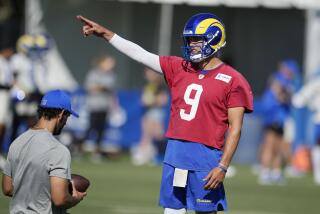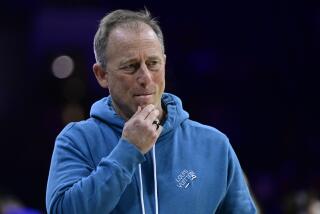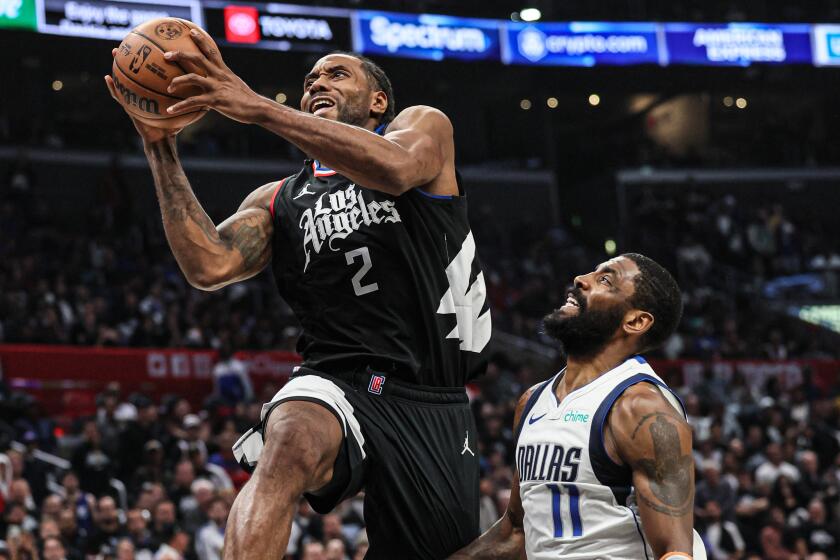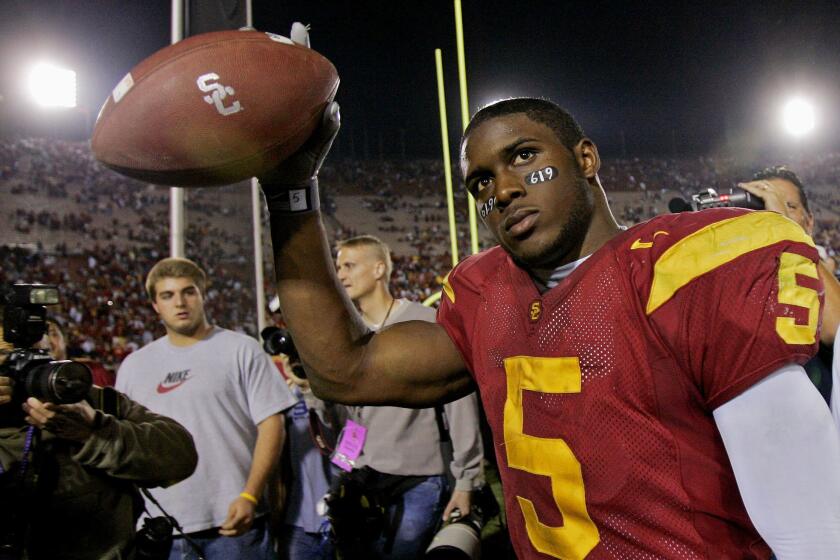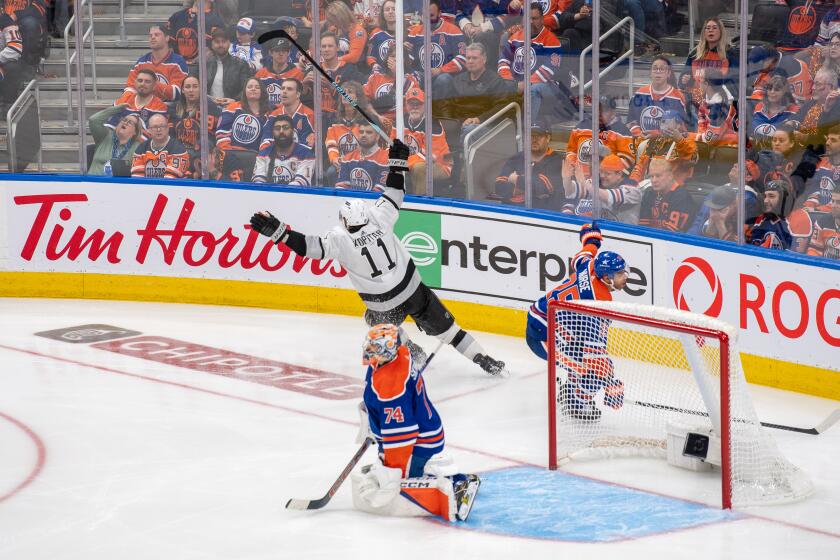NFL is back in business as player representatives OK 10-year deal
The NHL locked out players for a full season because cash-strapped teams were melting down.
The NBA has enacted a lockout because clubs are hemorrhaging red ink.
The NFL shut its doors because owners and players couldn’t agree on how to divide their riches.
The battle of the football haves and have lots — one that elicited little public sympathy — effectively came to a close Monday when the player representatives for all 32 teams unanimously agreed to accept the league’s proposal for a 10-year collective-bargaining agreement.
“It’s been a long time coming,” NFL Commissioner Roger Goodell said. “Football is back and that’s great news for everybody.”
In striking a deal, the sides ended the longest work stoppage in league history and the first since the 1987 players’ strike. Football resumes in earnest Tuesday when clubs can sign rookies and undrafted free agents. Thirty teams will open training camps on Wednesday, Thursday and Friday at a rate of 10 per day. Houston and the New York Jets will not begin camp until Sunday.
As part of the accord, the sides settled all unresolved litigation and neither has the ability to opt out of the deal that runs through the 2020 season. The entire group of 1,900 players still has to vote to re-form as a union and accept the deal, but those are considered formalities.
The deal sorts through how the nation’s most successful sports league will distribute its $9.3 billion in annual revenue; limits how much hitting players can do during the off-season, training camps and game weeks; distributes more money to veteran players and increases benefits to retired ones; and could help grease the skids for the league’s eventual return to the Los Angeles market.
Lifted is the 4½-month lockout that imperiled the regular season and threatened to seriously damage a league that has enjoyed unparalleled success and sets record TV numbers each year. It is likely in the coming years that the league will negotiate a new television contract for a season-long Thursday football package. Currently, there are eight Thursday night games broadcast each season.
“I know it has been a very long process since the day we stood here that night in March,” said NFLPA Executive Director DeMaurice Smith, referring to the collapse of negotiations that led to the lockout. “But our guys stood together when nobody thought we would. And football is back because of it.”
Flanked by Smith, as well as a cluster of owners and players, Goodell acknowledged the league will have to work diligently to win back fans soured by the labor fight.
“We know what we did to frustrate our fans over the last several months,” Goodell said. “They want football, and our job is to give them football.…
“We have some work to do to make sure they understand that we are sorry for the frustration we put them through over the last six months. Our commitment is to bring them better football going forward.”
From a fan’s perspective, the game won’t change much this season. Other than the cancellation of the Aug. 7 Hall of Fame game, and a condensed free-agency period, training camps will go on as planned. There will be limitations on how many times players can practice in pads and helmets — a byproduct of a renewed focus on player safety — and top rookies will no longer be the richest people on the roster.
For instance, former Auburn quarterback Cam Newton, the No. 1 overall pick of the Carolina Panthers, is expected to make roughly $22 million over four years. By comparison, St. Louis quarterback Sam Bradford, the first player selected in 2010, got a six-year, $78-million deal with $50 million of that guaranteed.
Under the new deal, rookies will sign four-year contracts with fifth-season options for players chosen in the opening round.
Unlike the NHL and NBA, the NFL could not claim that teams were losing money — only that owners weren’t making enough money to justify a huge investment in the game in the form of $1-billion stadiums, more international games, new-media opportunities and the like.
In 2008, owners unanimously voted to opt out of the CBA, a three-year process. The players said they would have been happy to stay with the old system.
Adding a layer of complexity to the deal was Goodell and Smith negotiating their first labor agreement, following in the considerable footsteps of former commissioner Paul Tagliabue and the late Gene Upshaw, the Hall of Fame offensive lineman and longtime union head. Both Goodell and Smith were answering to hard-to-please constituencies who were unwilling to move backward an inch.
Eventually, the ice began to thaw between the sides, who knew that at some point they would have to begin acting like partners again.
The new deal calls for the sides to split the league’s total revenue, with owners getting 53% and players 47% (replacing an arrangement that was closer to 50/50).
“The part that was most impressive to me was when the players and owners began to sit across the table from each other and dialogue,” said Jeff Saturday, the Indianapolis Colts center who was heavily involved in the negotiations. “Things began to happen.”
The agreement keeps the regular season at 16 games, as opposed to the owner-proposed 18, and ends federal court oversight of the pact. Some issues, including blood testing for human growth hormone, cannot be decided until the players reconstitute their union.
Benefits for retired players will be increased with additional funding of $900 million to $1 billion over the next 10 years. The largest single amount of $620 million will be earmarked for a “Legacy Fund” to increase pensions for pre-1993 retirees.
Also addressed in the agreement are mechanisms to help create stadium solutions in California. The deal allows for owners and players to set aside money to invest in new venues, including proposed stadiums in the Bay Area, San Diego and the L.A. area.
Hall of Fame coach John Madden, now a special consultant to the league, said that at one point he was worried that games would be canceled.
“When I had a real concern is when I’d watch TV and they’d show the pictures of the negotiations, and I didn’t know one guy in there,” he said. “They were all lawyers with briefcases. I said, ‘No, this isn’t the way.’ We had to get it out of their hands.
“They finally got it out of the courts and back into the hands of the owners and players.… They’re the custodians of the game.”
twitter.com/LATimesfarmer
More to Read
Get our high school sports newsletter
Prep Rally is devoted to the SoCal high school sports experience, bringing you scores, stories and a behind-the-scenes look at what makes prep sports so popular.
You may occasionally receive promotional content from the Los Angeles Times.

